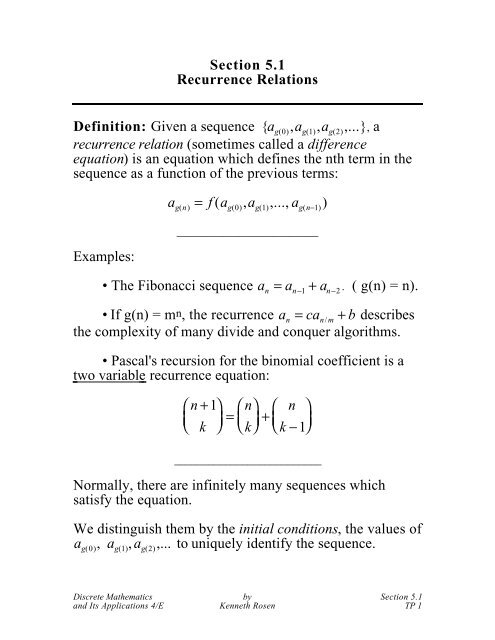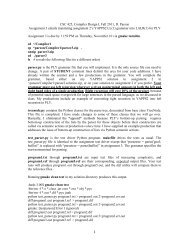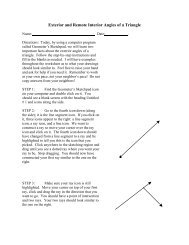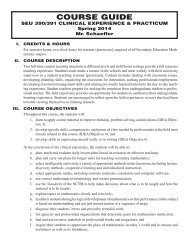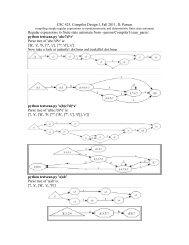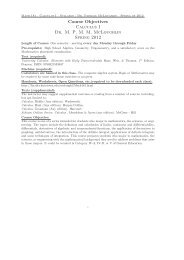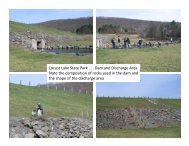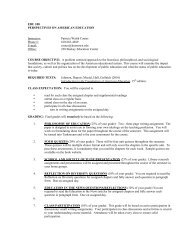Section 5.1 Recurrence Relations Definition: Given a sequence {ag ...
Section 5.1 Recurrence Relations Definition: Given a sequence {ag ...
Section 5.1 Recurrence Relations Definition: Given a sequence {ag ...
Create successful ePaper yourself
Turn your PDF publications into a flip-book with our unique Google optimized e-Paper software.
<strong>Section</strong> <strong>5.1</strong><br />
<strong>Recurrence</strong> <strong>Relations</strong><br />
<strong>Definition</strong>: <strong>Given</strong> a <strong>sequence</strong> {a g(0) ,a g(1) ,a g(2) ,...}, a<br />
recurrence relation (sometimes called a difference<br />
equation) is an equation which defines the nth term in the<br />
<strong>sequence</strong> as a function of the previous terms:<br />
Examples:<br />
a g(n) = f (a g(0) ,a g(1) ,..., a g(n−1) )<br />
_________________________<br />
• The Fibonacci <strong>sequence</strong> a n = a n−1 + a n−2 . ( g(n) = n).<br />
• If g(n) = mn, the recurrence a n = ca n/m + b describes<br />
the complexity of many divide and conquer algorithms.<br />
• Pascal's recursion for the binomial coefficient is a<br />
two variable recurrence equation:<br />
⎛ n +1⎞<br />
⎝<br />
⎜<br />
k ⎠<br />
⎟ = ⎛ n ⎝<br />
⎜ ⎞ ⎛ n ⎞<br />
k ⎠<br />
⎟ +<br />
⎝<br />
⎜<br />
k −1⎠<br />
⎟<br />
__________________________<br />
Normally, there are infinitely many <strong>sequence</strong>s which<br />
satisfy the equation.<br />
We distinguish them by the initial conditions, the values of<br />
a g(0) , a g(1) , a g(2) ,... to uniquely identify the <strong>sequence</strong>.<br />
Discrete Mathematics by <strong>Section</strong> <strong>5.1</strong><br />
and Its Applications 4/E Kenneth Rosen TP 1
__________________<br />
Examples:<br />
a 1<br />
• In the Fibonacci recurrence we must specify a 0 and<br />
• In the divide and conquer recurrence we must<br />
specify a m<br />
0 = a 1 .<br />
• In Pascal's identity we must specify C(1,0) and<br />
C(1,1).<br />
Example:<br />
_______________<br />
If f(n) = 3 n , find a recursive definition for f:<br />
• Initial condition: f(0) = 3 0 = 1<br />
• <strong>Recurrence</strong> relation:<br />
f(n + 1) = 3 (n+1) = 3(3 n ) = 3 f(n)<br />
so<br />
f(n+1) = 3 f(n)<br />
Modeling with <strong>Recurrence</strong> <strong>Relations</strong><br />
Discrete Mathematics by <strong>Section</strong> <strong>5.1</strong><br />
and Its Applications 4/E Kenneth Rosen TP 2
Many relationships are most easily described using<br />
recurrence relations.<br />
Examples:<br />
• EASY:<br />
______________<br />
At the credit union interest is compounded at 2% annually.<br />
If we do not withdraw the interest, find the total amount<br />
invested after n years if the initial amount deposited is d.<br />
• HARD:<br />
Initial Condition: a 0 = d<br />
<strong>Recurrence</strong> equation: a n = (1.02)a n−1<br />
_________________________<br />
Find a recurrence relation for the number of bit strings of<br />
length n which contain 3 consecutive 0's.<br />
Let S be the set of all such strings.<br />
First define the set inductively BUT in such a way as to<br />
avoid counting the same string twice:<br />
• Basis: 000 is in S<br />
• Induction (1): if w is in S and u and v are in<br />
{0,1}* then uwv is in S.<br />
• Extremal clause: (as usual)<br />
_________________<br />
Discrete Mathematics by <strong>Section</strong> <strong>5.1</strong><br />
and Its Applications 4/E Kenneth Rosen TP 3
The above definition is adequate to define S but NOT for<br />
counting (why)<br />
A better induction clause:<br />
Induction (2): if w is in S and u is in {0,1}* then<br />
• 1w<br />
• 01w<br />
• 001w<br />
• 000u<br />
are in S.<br />
This yields the recurrence<br />
a n = a n−1 + a n−2 + a n−3 + 2 n−3<br />
with initial conditions:<br />
a 3 = 1, a 4 = 3, a 5 = 8<br />
• a 3 ::<br />
- {000}<br />
• a 4 ::<br />
- {1000, 0000, 0001} since 1w is in S<br />
Discrete Mathematics by <strong>Section</strong> <strong>5.1</strong><br />
and Its Applications 4/E Kenneth Rosen TP 4
Check:<br />
• a 5 ::<br />
- 11000, 10000, 10001 since 1w is in S<br />
- 01000, since 01w is in S<br />
- 00000, 00001, 00010, 00011 since wu is in S<br />
• a 6 = a 5 + a 4 + a 3 + 23 = 8 + 3 + 1 + 8 = 20<br />
a 5 :: 111000, 110000, 110001, 101000, 100000,<br />
100001, 100010, 100011 = 8<br />
a 4 : 011000, 010000, 010001 = 3<br />
a 3 :: 001000 = 1<br />
23: 000000, 000001, 000010, 000011, 000100,<br />
000101, 000110, 000111 = 8<br />
Every string is present and nothing is counted twice.<br />
More Examples:<br />
_____________________<br />
Find a recursive program which determines if a bit<br />
string has at most a single 1.<br />
Then determine the worst case number of recursive<br />
calls for a string of length n.<br />
Discrete Mathematics by <strong>Section</strong> <strong>5.1</strong><br />
and Its Applications 4/E Kenneth Rosen TP 5
Recall the recursive definition:<br />
• Basis:<br />
• Induction:<br />
0, λ , 1 are in S.<br />
If w is in S then so are 0w and w0.<br />
• Extremal clause: (as usual)<br />
A recursive procedure:<br />
_______________<br />
procedure at_most_one_1 (string, basis)<br />
/* a recursive procedure to determine if a bit string has at<br />
most a single 1 based on the recursive definition.<br />
- string: the input bit string;<br />
- basis: a variable to remember a ‘1’ has been found<br />
at a higher level in the recursion.<br />
- If another ‘1’ is found, the string is not in the<br />
langu<strong>ag</strong>e and we pass back ‘NO’. Else ‘YES’ */<br />
/* basis step: */<br />
if string = λ or string = ‘0’ then<br />
return ‘YES’<br />
Discrete Mathematics by <strong>Section</strong> <strong>5.1</strong><br />
and Its Applications 4/E Kenneth Rosen TP 6
if string = ‘1’ and basis = 0 then<br />
return ‘YES’<br />
else<br />
if string =‘1’ and basis = 1 then return ‘NO’<br />
/* inductive step */<br />
if first and last character of string = ‘0’ then return<br />
at_most_one_1 (remainder of string, basis)<br />
if first and last character of string = ‘1’ return ‘NO’<br />
if first or last character of string = ‘1’ and<br />
basis = 0 then return at_most_one_1 (remainder<br />
of string, 1)<br />
return ‘NO’<br />
____________<br />
The procedure is called with the string to be tested and the<br />
basis variable set to zero .<br />
At any level we check both the first and last character of<br />
the input string.<br />
We assume the string is all zeros until we find a ‘1’. Then<br />
we set the basis variable to one .<br />
If we find two ones at the same time, we return ‘NO’<br />
If we find another ‘1’ and the basis variable is one, then<br />
we return ‘NO’, else we keep on stripping off zeros from<br />
Discrete Mathematics by <strong>Section</strong> <strong>5.1</strong><br />
and Its Applications 4/E Kenneth Rosen TP 7
the front and the back until we get to the empty string or a<br />
single character.<br />
_____________<br />
Let f(n) be the number of recursive calls to the procedure<br />
(worst case) where n is the length of the input string.<br />
• Basis: f(0) = f(1) = 0<br />
• Induction: f(n) = f(n-2) + 1<br />
______________________<br />
Discrete Mathematics by <strong>Section</strong> <strong>5.1</strong><br />
and Its Applications 4/E Kenneth Rosen TP 8


